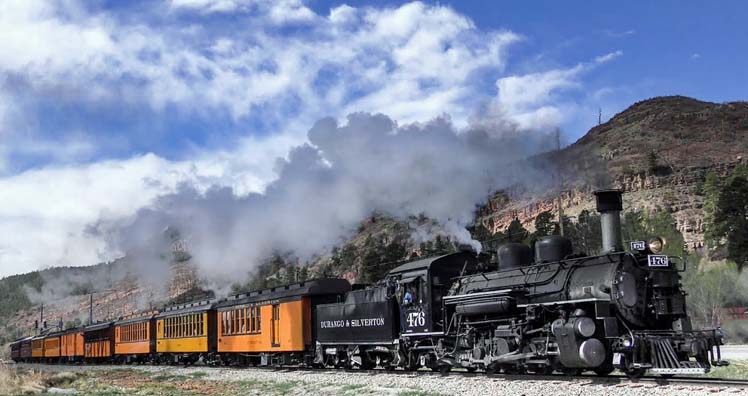
Ready to Rumble
Durango Colorado USA - A storied veteran will soon come out of retirement to again scale mountains in southwest Colorado.
The Durango & Silverton Narrow Gauge Railroad's locomotive 476 in February will take to the tracks for the first time since 1999.
The 1923 steam-powered engine's re-introduction comes after a multi-year, US$1 million rebuild made possible by resurgent ridership on the historic rail line through the San Juan National Forest.
The locomotive is one of 10 steam engines owned by the company and, along with its sister the 473, is the oldest still able to be used in regular operations on the historic railroad, first established in 1881 as the Denver & Rio Grande Railway.
It was 476 that hauled the Durango & Silverton Narrow Gauge Railroad's first passenger train in 1981.
Officials say the lengthy restoration process provided the railroad's maintenance crew with valuable experience that will help protect all 10 engines in its stable well into the future.
"This is probably the most historic engine that we operate on a regular basis," said Allen Harper, co-owner and CEO of the Durango & Silverton Narrow Gauge Railroad.
"More than that, it's a celebration of the whole historic preservation process and the fact that we have a program now that will make sure these steam engines will be available for generations to come."
Number 476 is one of a family of 10 470 series locomotives built by the American Locomotive Company in 1923, according to American Heritage Railways, Harper's family-run company that owns the Durango & Silverton Narrow Gauge, as well as historic railroads in Washington and North Carolina.
The sibling engines served the entire Denver & Rio Grande Western Railroad at one point, carrying passengers on routes such as the San Juan Express from Durango to Alamosa.
In 2001, the Federal Railroad Administration adopted new regulations that required major rebuilds of steam locomotives after every 1,472 service days, railroad officials said.
That meant that the already-shelved 476 needed an overhaul to return to action.
Then, in 2002, the Missionary Ridge wildfire burned 71,739 acres near Durango and ridership on the popular tourist railroad fell dramatically.
After reaching a peak of about 213,000 riders a year in the 1980s, ridership the year of the fire fell to just 130,000, Harper said.
Number 476 was out indefinitely.
"We just didn't have the passenger levels to justify the million-dollar fix," Harper said.
But in the years since, the railroad has diversified its offerings and expanded its appeal.
While nostalgic train fans still make up roughly 20 percent of riders, Harper said his company has focused on making the railroad attractive to people of all ages and demographics by adding excursion rides to special destinations and a variety of special events.
There is "The Brew Train," which introduces riders to craft brewers and their beer, and "The Durango Blues Train," which features live bands.
"The Polar Express" Train Ride, based the classic children's book and movie, will welcome about 30,000 riders between Nov. 17 November and 2nd January, Harper said.
The CEO expects the Durango & Silverton Narrow Gauge to close out 2017 with more than 200,000 riders.
With 476 ready for action again, its first job will be powering the company's Winter Photography Train on 17 and 18 Feb 2018.
Harper is excited about the future.
"It just gives us the capacity to do huge numbers that we haven't done in years," he said.
Harper said the plan for his railroad going forward is to have up to six engines in service at one time, three stationary, and one in overhaul.
Randy Babcock, the railroad's mechanical foreman, said rebuilding 476 provided his team with valuable experience that should help lengthen the life of all 10 of the company's engines, each an average 90-years-old.
"We're always pressed for time getting our engines ready to run, so the chance to work on a multi-year rebuild allowed our crew to expand its skill set, especially on the finer points of boiler making and locomotive machining," Babcock said in a news release.
"Number 476 is really just the first of our engines to receive some of this work."
Count Charles Proudfoot among the people excited to hear of 476's impending return to service.
He is the president of Friends of the 169, a volunteer group that is striving to see Engine 169, an 1883 locomotive now on display in Alamosa, returned to working order.
Proudfoot noted that 476 is lucky to still be around at all.
Seven of its 470 series sister engines were requisitioned by the U.S. Army during World War II and sent to Alaska to help with the war effort before being broken down for scrap.
Now she'll be back in action on some of the same routes she carried riders on 90 years ago.
"Anytime any of us in restoration area see a locomotive returned to service, we're all happy," Proudfoot said.
"That's simply good for everybody."
Brandon Mathis.
provisions in Section 29 of the Canadian
Copyright Modernization Act.


